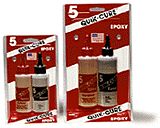QUICK CURE 5 Minute Epoxy (9oz)
QUIK-CURE 5 min. epoxy cures to a slightly flexible consistency. This lack of brittleness allows it to form a lasting bond in areas subjected to high vibration or stress. QUIK-CURE shouldn't be used in areas that are subject to long-term immersion in water; however, it works fine for the internal structure of wood framed boats. QUIKCURE is our only epoxy on which you can apply polyester resins. It can be mixed with microballoons to form a quick setting putty. Items bonded with QUIK-CURE can be handled after 15 minutes. Full strength is reached in 1 hour.
You Might Also Like
Features
QUICK CURE 5 Minute Epoxy
Specs
- Hobbylinc Product Number: 202
Includes
9oz bottle
Requirements & Suggestions
Product Rank
Reviews |
Information
If CAs are the cure-all for just about all bonding problems, you may be wondering, "Why do I need epoxy?" One primary reason is price. Epoxy costs are about one fourth that of CA. When large objects are being bonded, economics can be a deciding factor on choice of adhesive. The specific characteristics of epoxies also give them advantages in some applications. All our epoxies are mixed with a 50-50 ratio. Any scrap material or paper scratch pad can be used as a mixing surface. We have found, however, that the plastic tops to coffee cans work best due to their outer border and their flexibility, which allows the unused cured epoxy to be released and thrown away.
Squeeze out equal length beads of the desired amount of epoxy, then mix together thoroughly with a popsicle stick or scrap piece of material. In cold weather, epoxy takes longer to cure (too cold and usually they never fully cure) and becomes more difficult to get out of the bottle, especially if it's less than 1/2 full. The epoxies can be heated in a microwave oven for about 10 seconds so that they flow easier. The heating process, with the caps off, also releases any moisture that can be absorbed by epoxies. Their shelf life, therefore, is virtually unlimited.
Acetone works as the best solvent for cleaning epoxy from brushes and unwanted surfaces before it cures. If epoxy gets on surfaces that acetone will attack, use isopropyl alcohol. We do not recommend any additives for thinning epoxies due to their effect on curing and overall strength. If thin epoxy is required, either use heat or switch to EX-SLOW or FINISH-CURE. Epoxies bond best to clean, textured surfaces. Smooth, non-porous surfaces should be roughened with coarse sandpaper to improve adhesion.
A small amount of CA can be used in strategic locations to hold parts in place while the epoxies cure. The minute designations for epoxies refer to the working time, i.e., the time one has before the epoxies begin to set up after being mixed in a large mass. When spread into thinner layers, the working time in increased significantly (except QUIK-CURE). Working time decreases approximately 25% at temperatures above 90 degrees F. Don't panic if your skin comes in contact with either epoxy or CA.
While contact should be avoided, uncured epoxy can be washed from your skin with soap and water. Allergic reactions are rare. Cured epoxy and CA can be peeled off the skin and usually are gone after a full day of normal activity. UN-CURE will debond any body parts that get stuck together if a peeling action (never pulling) doesn't part them.
